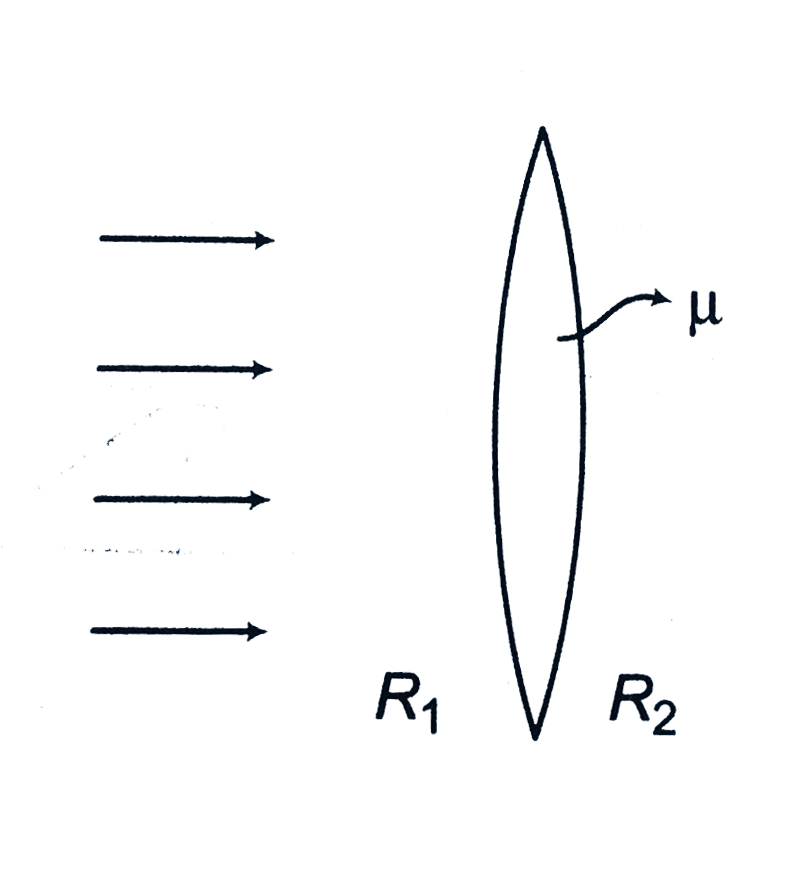Statement-1 : Focal length of an equiconvex lens of μ=3/2 is equal to radius of curvature of each surface.
Statement-2 : it follows from
1f=(μ−1)(1R1−1R2)
Statement-1 is true, Statement-2 is true.
Statement-2 is correct explanation of Statement-1.
Statement-1 is true, Statement-2 is true, but Statement-2 is not a correct explanation of Statement-1.
Statement-1 is true, Statement-2 is false.
Statement-1 is fasle, Statement-2 is true.
The correct Answer is:A
For an equiconvex lens, if R1=R,R2=−R
∴1f=(32−1)(1R+1R)=1R
f=R
Hence both the statement are true and statement-2 is correct explanation of statement-1.
Topper's Solved these Questions
- OPTICSBook:PRADEEPChapter:OPTICSExercise:Problems for practice
Explore 4 Videos
- OPTICSBook:PRADEEPChapter:OPTICSExercise:Comprehension 1
Explore 1 Video
- OPTICSBook:PRADEEPChapter:OPTICSExercise:Value based questions
Explore 3 Videos
- MAGNETIC EFFECT OF CURRENT AND MAGNETISMBook:PRADEEPChapter:MAGNETIC EFFECT OF CURRENT AND MAGNETISMExercise:Competition Focus (Multiple Choice Questions)
Explore 2 Videos
Similar Questions
Knowledge Check
The focal length of equiconvex lens of retractive index, μ=1.5 and radius of curvature, R is
AR1.5B1.5RCRD1.5RSTATEMENT-1 Power of a lens depends on nature of material of lens, medium in which it is placed and radii of curvature of its surface.
STATEMENT2 it follows the relationp=1f=(μ2μ1−1)[1R1−1R2]ASTATEMENT -1is true statement 2 is true,Statement -2is a correct explanation for statement -1BSTATEMENT -1is true statement 2 is true,Statement -2is a not a correct explanation for statement -1CStatement -1is true,Statement -2is FalseDStatement -1is False ,Statement -2is TrueWhat is the focal length of double convex lens for which radius of curvature of either of the surfaces is 30 cm? [aμg=1.5]
A50 cmB30 cmC−30cmD−50cm
A convex lens, μ=1.4 both sides R1, R2 to radius of curvature of both sides. Focal length = ?
View SolutionA biconvex lens (μ=1.5) has radius of curvature 20cm (both).
find its focal length.

View SolutionA plano-convex lens μ=1.5 has focal length of 18 cm in air. Calculate the radius of curvature of the spherical surface.
View SolutionStatement-1 : A glass convex lens (refractive index, μ1=1.5), when immersed in a liquid of refractive index μ2=2, functions as a diverging lens.
Statement-2 : The focal length of a lens is given by 1f=(μ−1)(1R1−1R2), where μ is the relative refractive index of the material of the lens with respect to the surrounding medium.
View SolutionA planoconvex lens is made of refractive index 1.6. The radius of curvature of curved surface is 60 cm. The focal length of the lens is
View Solution

